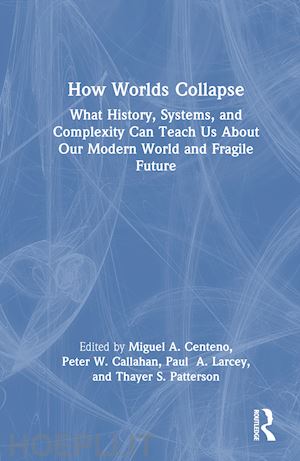
-
DISPONIBILITÀ IMMEDIATA
{{/disponibilitaBox}}
-
{{speseGratisLibroBox}}
{{/noEbook}}
{{^noEbook}}
-
Libro
-
156,98 €
149,13 €
{{{disponibilita}}}
NOTE EDITORE
As our society confronts the impacts of globalization and global systemic risks—such as financial contagion, climate change, and epidemics—what can studies of the past tell us about our present and future? How Worlds Collapse offers case studies of societies that either collapsed or overcame cataclysmic adversity. The authors in this volume find commonalities between past civilizations and our current society, tracing patterns, strategies, and early warning signs that can inform decision-making today. While today’s world presents unique challenges, many mechanisms, dynamics, and fundamental challenges to the foundations of civilization have been consistent throughout history—highlighting essential lessons for the future.SOMMARIO
Introduction Section 1: Theory and Insights of Historical Collapse 1. Globalization and Fragility: A Systems Approach to CollapseMiguel A. Centeno, Peter W. Callahan, Paul A.Larcey, and Thayer Patterson S. 2. How Scholars Explain CollapseJoseph A. Tainter 3. Diminishing Returns on Extraction: How Inequality and Extractive Hierarchy Create FragilityLuke Kemp 4. Collapse, Recovery, and Existential RiskHaydn Belfield Section 2: Historical and Archaeological Investigations of Collapse 5. "Mind the Gap": The 1177 BCE Late Bronze Age Collapse and Some Preliminary Thoughts on Its Immediate AftermathEric H. Cline 6. The End of "Peak Empire": The Collapse of the Roman, Han, and Jin EmpiresWalter Scheidel 7. Collapse and Non-collapse: The Case of Byzantium ca. 650-800 CEJohn Haldon 8. Fluctuat Nec Mergitur: Seven Centuries of Pueblo Crisis and ResilienceTimothy A. Kohler, R. Kyle Bocinsky, and Darcy Bird 9. Episodes of the Feathered Serpent: Aztec Imperialism and CollapseDeborah L. Nichols, Ryan H. Collins 10. The Black Death: Collapse, Resilience, and TransformationSamuel K. Cohn, Jr 11. The Cases of Novgorod and Muscovy: Using Systems Thinking to Understand Historical Civilizational Response to Exogenous ThreatsMiriam Pollock, Benjamin D. Trump, andIgor Linkov 12. Resilience of the Simple? Lessons from the Blockade of LeningradJeffrey K. Hass Section 3: Systemic Collapse Insights from Ecology, Climate, and the Environment 13. Climate Change and Tipping Points in Historical CollapseTimothy M.Lenton 14. Conservation of Fragility and the Collapse of Social OrdersJohn M. Anderies andSimon A. Levin 15. Resilience and Collapse in Bee Societies and CommunitiesChristina M. Grozinger andHarland M. Patch Section 4: Future Systemic Collapse and Quantitative Modeling 16. Producing Collapse: Nuclear Weapons as Preparation to End CivilizationZia Mian andBenoît Pelopidas 17. From Wild West to Mad Max: Transition in CivilizationsRichard Bookstaber 18. Phase Transitions and the Theory of Early Warning Indicators for Critical TransitionsGeorge I. Hagstrom andSimon A. Levin 19. The Lifespan of Civilizations: Do Societies "Age," or Is Collapse Just Bad Luck?Anders Sandberg 20. Multipath Forecasting: The Aftermath of the 2020 American CrisisPeter TurchinAUTORE
Miguel A. Centeno is Musgrave Professor of Sociology at Princeton University and Executive Vice Dean of Princeton University’s School of Public and International Affairs. He is founder and co-director of the Princeton Institute for International and Regional Studies (PIIRS) Global Systemic Risk research community. Peter W. Callahan is a graduate of Princeton University who earned his MS in Geography and Environmental Studies from the University of New Mexico. He is a researcher at Princeton’s PIIRS Global Systemic Risk research community where his scholarly interests include the study of socio-ecological systems, historical systemic risks, sustainable development, and renewable energy policy and technology. Paul A. Larcey is co-director of the PIIRS Global Systemic Risk research community at Princeton University. Larcey’s work with the UK’s innovation agency focuses on key emerging technologies including life sciences, quantum technologies, and AI. He has worked in corporate research, venture capital, and global industrial sectors at board and senior levels and studied engineering, materials science, and finance at London, Oxford, and Cambridge Universities. Thayer S. Patterson is coordinator and a founding member of the PIIRS Global Systemic Risk research community at Princeton University. Following his studies in economics and mechanical engineering at Yale, and finance at Princeton’s Bendheim Center for Finance, his research has focused on the causes and consequences of catastrophic systemic risk.ALTRE INFORMAZIONI
- Condizione: Nuovo
- ISBN: 9781032363257
- Dimensioni: 9 x 6 in Ø 1.59 lb
- Formato: Copertina rigida
- Illustration Notes: 43 b/w images, 8 tables and 43 line drawings
- Pagine Arabe: 426
- Pagine Romane: xvi
